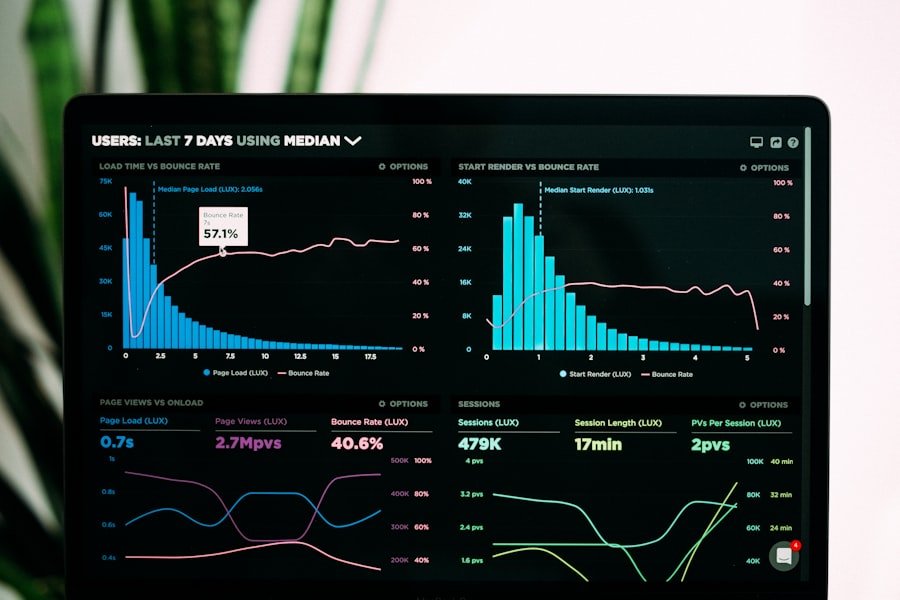In the ever-evolving landscape of digital marketing, the significance of social media creator database analytics cannot be overstated. As we navigate through a world increasingly dominated by social media platforms, the ability to harness data from these creators becomes paramount for brands seeking to connect with their target audiences. Social media creators, ranging from influencers to content producers, have transformed the way we perceive marketing and advertising.
They possess the unique ability to engage with their followers on a personal level, making their insights and analytics invaluable for brands aiming to enhance their outreach and effectiveness. By analyzing creator databases, we can uncover trends, preferences, and behaviors that inform our marketing strategies, ultimately leading to more successful campaigns. Moreover, the integration of analytics into our understanding of social media creators allows us to make data-driven decisions that can significantly impact our marketing efforts.
The sheer volume of content generated daily across various platforms presents both challenges and opportunities. As we delve into the intricacies of creator database analytics, we begin to appreciate how these insights can guide us in selecting the right creators for our campaigns, optimizing our messaging, and measuring the effectiveness of our strategies. In this article, we will explore the various facets of social media creator database analytics, from understanding influence and engagement metrics to leveraging data for informed decision-making in influencer marketing.
Key Takeaways
- Social media creator database analytics provide valuable insights into creator impact and audience behavior
- Influence and engagement metrics help to understand the effectiveness of creator content and audience interaction
- Identifying key performance indicators is crucial for evaluating campaign potential and success
- Utilizing data to measure creator impact allows for informed decision-making in influencer marketing strategy
- Analyzing audience demographics and behavior helps to tailor content and campaigns for maximum impact
Understanding Influence and Engagement Metrics
Influence and Engagement: The Key to Unlocking Campaign Success
Influence refers to a creator’s ability to sway their audience’s opinions or behaviors, while engagement metrics measure how actively their followers interact with their content. These metrics are crucial for brands as they provide insight into a creator’s reach and the potential impact they can have on a campaign.
Identifying Creators with Genuine Connections
By analyzing these metrics, we can identify creators who not only have a substantial following but also foster genuine connections with their audience, ensuring that our marketing messages resonate with potential customers. Engagement metrics encompass various indicators such as likes, shares, comments, and overall interaction rates. These figures help us assess how well a creator’s content is received by their audience.
Making Informed Decisions with Data-Driven Insights
For instance, a creator with a smaller following but high engagement rates may be more effective for niche campaigns than one with millions of followers but low interaction levels. By understanding these nuances, we can make informed decisions about which creators align best with our brand values and objectives. Ultimately, a comprehensive understanding of influence and engagement metrics empowers us to select creators who can authentically represent our brand and drive meaningful interactions with their audience.
Identifying Key Performance Indicators for Campaign Potential

As we delve deeper into social media creator database analytics, identifying key performance indicators (KPIs) becomes essential for evaluating campaign potential. KPIs serve as measurable values that demonstrate how effectively a creator can achieve specific marketing objectives. By establishing clear KPIs tailored to our campaign goals, we can assess the effectiveness of our chosen creators and make necessary adjustments throughout the campaign lifecycle.
Common KPIs include reach, impressions, engagement rate, conversion rate, and return on investment (ROI). Each of these indicators provides valuable insights into how well a creator is performing in relation to our objectives. In addition to traditional KPIs, we should also consider qualitative factors that may influence campaign success.
For instance, brand alignment is crucial; a creator whose values resonate with our brand ethos is more likely to produce authentic content that engages their audience. Furthermore, analyzing past campaign performance can provide context for future initiatives. By examining how similar campaigns fared with specific creators, we can better predict potential outcomes and refine our strategies accordingly.
Ultimately, identifying and monitoring KPIs allows us to gauge the effectiveness of our influencer partnerships and ensure that we are maximizing our marketing efforts.
Utilizing Data to Measure Creator Impact
Utilizing data to measure creator impact is a fundamental aspect of social media creator database analytics that cannot be overlooked. By systematically collecting and analyzing data related to a creator’s performance, we can gain insights into their effectiveness in driving brand awareness and engagement. This process involves tracking various metrics over time, allowing us to identify trends and patterns that inform our understanding of a creator’s impact on our campaigns.
For instance, by monitoring engagement rates before, during, and after a campaign launch, we can assess how well a creator’s content resonates with their audience and whether it translates into tangible results for our brand. Moreover, measuring creator impact extends beyond mere numbers; it also involves understanding the qualitative aspects of their influence. We should consider factors such as sentiment analysis—evaluating the tone of comments and interactions on a creator’s posts—to gauge audience perception of our brand.
Additionally, tracking referral traffic from a creator’s content to our website can provide insights into how effectively they drive potential customers to engage with our products or services. By combining quantitative data with qualitative insights, we can develop a holistic view of a creator’s impact on our marketing efforts and make informed decisions about future collaborations.
Analyzing Audience Demographics and Behavior
A critical component of social media creator database analytics is analyzing audience demographics and behavior. Understanding who a creator’s audience is—age, gender, location, interests—enables us to tailor our marketing strategies effectively. By aligning our campaigns with creators whose audiences match our target demographic, we increase the likelihood of reaching potential customers who are genuinely interested in our products or services.
This alignment not only enhances engagement but also fosters authenticity in the messaging delivered through influencer partnerships. In addition to demographics, analyzing audience behavior provides further insights into how followers interact with content. We can examine patterns such as peak engagement times, preferred content formats (videos, stories, posts), and common themes that resonate with the audience.
This information allows us to optimize our campaigns by scheduling posts at times when engagement is highest or by creating content that aligns with audience preferences. By leveraging data on audience demographics and behavior, we can craft more targeted and effective influencer marketing strategies that resonate with consumers on a deeper level.
Leveraging Data to Inform Influencer Marketing Strategy

Informing Influencer Marketing Strategies with Data
Leveraging data to inform our influencer marketing strategy is crucial for maximizing the effectiveness of our campaigns. By utilizing insights gained from social media creator database analytics, we can make strategic decisions that enhance our outreach efforts. For instance, data-driven insights allow us to identify emerging trends within specific niches or industries, enabling us to stay ahead of the curve in our marketing initiatives.
Staying Ahead of the Curve with Emerging Trends
By aligning ourselves with creators who are at the forefront of these trends, we position our brand as relevant and innovative in the eyes of consumers. Furthermore, data enables us to refine our messaging and creative approach based on what resonates most with audiences. By analyzing past campaign performance data—such as engagement rates and conversion metrics—we can identify which types of content yield the best results.
Creating Tailored Campaigns with Data-Driven Insights
This information empowers us to create tailored campaigns that speak directly to consumer interests and preferences. By understanding what drives engagement and conversion, we can develop targeted marketing initiatives that drive real results.
Maximizing Return on Investment with Real-Time Analysis
Additionally, ongoing analysis throughout a campaign allows us to make real-time adjustments based on performance metrics, ensuring that we remain agile in our approach and maximize our return on investment.
Case Studies and Examples of Successful Campaigns
Examining case studies and examples of successful campaigns provides valuable lessons in the application of social media creator database analytics. One notable example is a beauty brand that partnered with micro-influencers to promote its new product line. By leveraging data analytics to identify creators whose audiences aligned closely with their target demographic—young women interested in skincare—the brand was able to craft personalized campaigns that resonated deeply with consumers.
The result was not only increased brand awareness but also significant sales growth attributed directly to influencer-driven traffic. Another compelling case study involves a fitness apparel company that utilized data analytics to inform its influencer partnerships strategically. By analyzing audience demographics and engagement metrics across various creators in the fitness niche, the brand identified key influencers who not only had large followings but also demonstrated high engagement rates within their communities.
The campaign involved collaborative content creation that showcased real-life testimonials from these influencers using the apparel during workouts. The result was an authentic connection with consumers that translated into increased sales and brand loyalty.
Best Practices for Using Social Media Creator Database Analytics
To effectively harness the power of social media creator database analytics, adhering to best practices is essential. First and foremost, we should prioritize transparency in our partnerships with creators. Establishing clear expectations regarding deliverables and performance metrics fosters trust between brands and influencers while ensuring accountability throughout the campaign lifecycle.
Additionally, maintaining open lines of communication allows us to address any challenges or adjustments needed in real-time. Another best practice involves continuously monitoring and analyzing data throughout the campaign process rather than waiting until its conclusion. By adopting an agile approach that allows for real-time adjustments based on performance metrics, we can optimize our strategies for maximum impact.
Furthermore, investing in robust analytics tools can streamline this process by providing comprehensive insights into creator performance and audience behavior. In conclusion, social media creator database analytics offers invaluable insights that empower brands to make informed decisions in their influencer marketing strategies. By understanding influence and engagement metrics, identifying key performance indicators, measuring creator impact, analyzing audience demographics and behavior, leveraging data for strategic planning, studying successful case studies, and adhering to best practices, we position ourselves for success in an increasingly competitive digital landscape.
As we continue to explore this dynamic field, embracing data-driven approaches will undoubtedly enhance our ability to connect authentically with consumers through social media creators.
For those interested in the intricacies of social media influence and campaign analytics, a related resource worth exploring is the article on music marketing companies. This article delves into how these companies leverage data analytics to enhance the visibility and influence of artists in the digital realm. Understanding the strategies employed can provide valuable insights into the broader scope of digital marketing and the role of analytics in crafting successful online campaigns. This is particularly relevant for those looking to measure and enhance their influence within the music industry through social media platforms.
FAQs
What is a social media creator database analytics?
Social media creator database analytics refers to the process of using data and analytics to measure the influence and campaign potential of social media creators. This involves analyzing various metrics such as engagement, reach, audience demographics, and content performance to determine the effectiveness of working with a particular creator for marketing campaigns.
Why is measuring influence and campaign potential important for social media creators?
Measuring influence and campaign potential is important for social media creators as it helps them understand the impact of their content and their ability to drive engagement and conversions for brands. It also allows creators to showcase their value to potential brand partners and negotiate fair compensation for their work.
What are some key metrics used in social media creator database analytics?
Some key metrics used in social media creator database analytics include engagement rate, follower growth, audience demographics, content performance (likes, comments, shares), reach, and conversion rates. These metrics help brands and creators understand the effectiveness of their content and the potential impact of collaboration.
How can social media creator database analytics help brands in influencer marketing?
Social media creator database analytics can help brands in influencer marketing by providing insights into the effectiveness of working with specific creators. It allows brands to identify the right creators for their target audience, measure the potential reach and engagement of a campaign, and track the return on investment for influencer partnerships.
What are some tools and platforms used for social media creator database analytics?
There are several tools and platforms used for social media creator database analytics, including social media management tools like Hootsuite and Sprout Social, influencer marketing platforms like AspireIQ and Upfluence, and analytics tools provided by social media platforms themselves, such as Instagram Insights and YouTube Analytics. These tools offer various features for measuring creator influence and campaign potential.



























